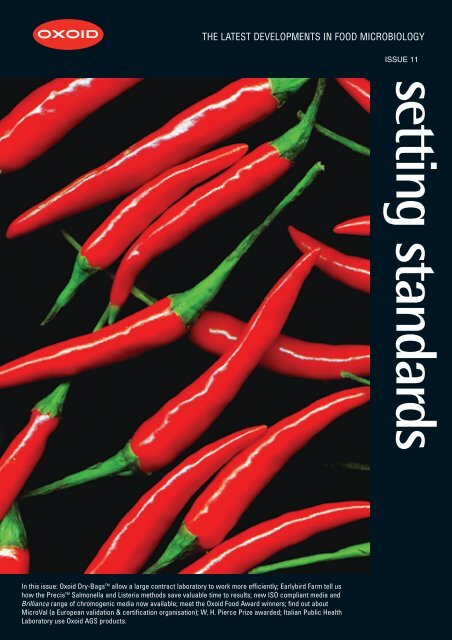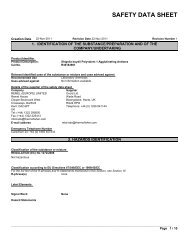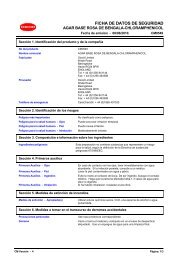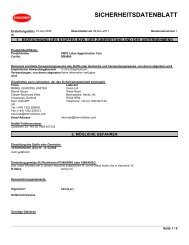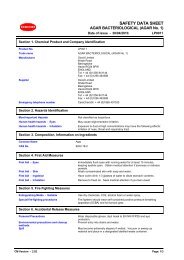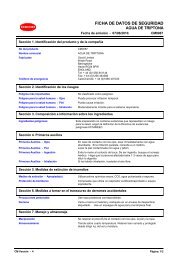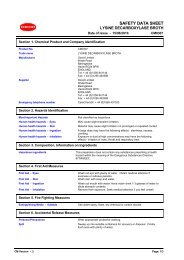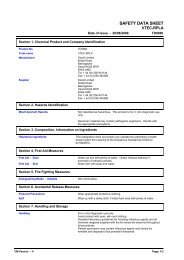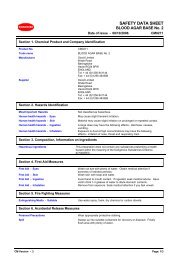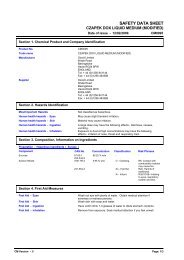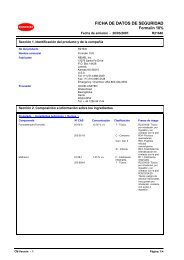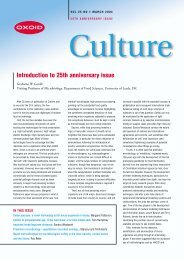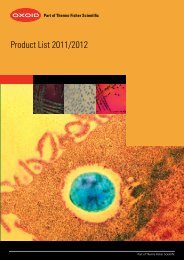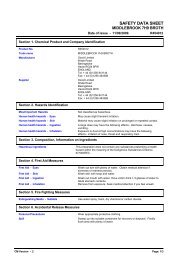The Latest Developments in Food Microbiology - Oxoid
The Latest Developments in Food Microbiology - Oxoid
The Latest Developments in Food Microbiology - Oxoid
You also want an ePaper? Increase the reach of your titles
YUMPU automatically turns print PDFs into web optimized ePapers that Google loves.
THE LATEST DEVELOPMENTS IN FOOD MICROBIOLOGY<br />
In this issue: <strong>Oxoid</strong> Dry-Bags TM allow a large contract laboratory to work more efficiently; Earlybird Farm tell us<br />
how the Precis TM Salmonella and Listeria methods save valuable time to results; new ISO compliant media and<br />
Brilliance range of chromogenic media now available; meet the <strong>Oxoid</strong> <strong>Food</strong> Award w<strong>in</strong>ners; f<strong>in</strong>d out about<br />
MicroVal (a European validation & certification organisation); W. H. Pierce Prize awarded; Italian Public Health<br />
Laboratory use <strong>Oxoid</strong> AGS products.<br />
ISSUE 11<br />
sett<strong>in</strong>g standards
<strong>Oxoid</strong> Dry-Bags TM<br />
as an Effective Alternative to Bulk<br />
Liquid Media Preparation<br />
ALcontrol Laboratories<br />
ALcontrol Laboratories is one of the largest laboratory service<br />
bus<strong>in</strong>esses <strong>in</strong> Europe, with laboratories <strong>in</strong> the United K<strong>in</strong>gdom,<br />
Benelux and Sweden offer<strong>in</strong>g services cover<strong>in</strong>g food, environmental,<br />
potable water, land, oil, asbestos and air test<strong>in</strong>g. ALcontrol<br />
<strong>Food</strong> is one of the UK market leaders <strong>in</strong> food analysis, with six<br />
laboratories throughout the UK.<br />
ALcontrol <strong>Food</strong> laboratories are UKAS group accredited to ISO<br />
17025, which gives them substantial capacity and cont<strong>in</strong>gency<br />
capability should unforeseen circumstances arise. <strong>The</strong> UK<br />
laboratories hold Independent Supplier Audits (ISAs) to facilitate<br />
analysis to M&S requirements and DEFRA approval for the animal<br />
feed <strong>in</strong>dustry.<br />
With a fleet of refrigerated vehicles across the network of<br />
laboratories, they provide customer sample collection throughout<br />
the whole of the UK. <strong>The</strong>ir <strong>in</strong>dustry-lead<strong>in</strong>g electronic report<strong>in</strong>g<br />
system (AMIS) provides results as rapidly as methods allow, and<br />
enables customers to easily store, manage, report and perform<br />
trend analysis of large amounts of data.<br />
ALcontrol services and capabilities:<br />
1 Comprehensive microbiological analysis utilis<strong>in</strong>g rapid<br />
methods where appropriate:<br />
1 Spoilage organisms such as Pseudomonas, yeasts<br />
and moulds<br />
1 Pathogens, for example, E. coli, Salmonella and<br />
Listeria<br />
1 <strong>Food</strong> poison<strong>in</strong>g organisms such as Staphylococcus<br />
aureus, Clostridium perfr<strong>in</strong>gens and Bacillus cereus<br />
1 Shelf-life test<strong>in</strong>g<br />
1 Test<strong>in</strong>g of products that are the subject of consumer<br />
compla<strong>in</strong>ts<br />
1 Bacterial identifications.<br />
2<br />
OPEN<br />
FILL<br />
DISPENSE<br />
Wide range of sample types<br />
ALcontrol analyses a vast range of sample types, from raw meat,<br />
raw fish, mechanically recovered meat and mycoprote<strong>in</strong> to milk,<br />
snacks, confectionery, ready meals, sandwiches, herbs & spices.<br />
Such a wide range of sample types necessitates a wide range of<br />
microbiological tests and methods. Enumeration tests, such as<br />
Aerobic Colony Count, E. coli, coliforms and S. aureus, are rout<strong>in</strong>ely<br />
performed. Some pathogen analyses, such as Salmonella, Listeria<br />
monocytogenes, Campylobacter and E. coli O157 aim to determ<strong>in</strong>e the<br />
presence or absence of the organism. <strong>The</strong>se tests require an enrichment<br />
process to ensure detection of even small levels <strong>in</strong> the product.<br />
With approximately 2.2 million samples analysed each year, it is<br />
imperative that processes are as efficient as possible.
Bulk liquid handl<strong>in</strong>g<br />
Buffered Peptone Water (BPW) is the ma<strong>in</strong> diluent used by<br />
ALcontrol <strong>in</strong> the preparation of samples. Each batch takes time to<br />
prepare <strong>in</strong> terms of weigh<strong>in</strong>g out media powder, measur<strong>in</strong>g liquid,<br />
and autoclav<strong>in</strong>g and cool<strong>in</strong>g bottles, which can take four to five<br />
hours. Staff availability, the number of runs per day and the number<br />
of autoclaves available all restrict the production of BPW.<br />
As the number of samples <strong>in</strong>creased at the Shrewsbury laboratory<br />
(now handl<strong>in</strong>g 65,000 tests per month), it was evident that the autoclave<br />
capacity for the manufacture of liquid media was becom<strong>in</strong>g<br />
a limit<strong>in</strong>g factor. <strong>The</strong> autoclaves were not cop<strong>in</strong>g well with runn<strong>in</strong>g<br />
24 hours a day, but the <strong>in</strong>stallation of further mach<strong>in</strong>es was not<br />
possible with<strong>in</strong> the timescale required.<br />
After consider<strong>in</strong>g other ideas, such as ready-filled options, <strong>Oxoid</strong><br />
Dry-Bags TM provided an ideal solution. Follow<strong>in</strong>g a short trial period,<br />
it was clear that they would fit well <strong>in</strong>to current procedures,<br />
enabl<strong>in</strong>g an <strong>in</strong>crease <strong>in</strong> media production and efficiency without<br />
heavy capital <strong>in</strong>vestment.<br />
<strong>Oxoid</strong> provided full tra<strong>in</strong><strong>in</strong>g for the laboratory staff and have cont<strong>in</strong>ued<br />
to support ALcontrol's tra<strong>in</strong><strong>in</strong>g requirements.<br />
Easy to use and cost effective<br />
“We are impressed by the Dry-Bags' ease of use," says Paul<br />
Anderson, site manager at ALcontrol, Shrewsbury. "<strong>The</strong>y fit directly<br />
onto Dilumats for dispens<strong>in</strong>g, thereby reduc<strong>in</strong>g the risk of contam<strong>in</strong>ation.<br />
As a disposable option, they elim<strong>in</strong>ate the time and expense<br />
of recycl<strong>in</strong>g glassware associated with <strong>in</strong>-house production. <strong>The</strong>y<br />
offer cost sav<strong>in</strong>gs <strong>in</strong> terms of runn<strong>in</strong>g the autoclaves (300 litres<br />
saves 3-4 autoclave runs) and through the reduction <strong>in</strong> QC checks<br />
necessary (the batch numbers of the Dry-Bags change far less<br />
than those of <strong>in</strong>-house BPW). All these factors lead to more<br />
efficient media production.<br />
“<strong>The</strong> performance pressures and wear and tear on the autoclaves<br />
is reduced", cont<strong>in</strong>ues Paul. "<strong>The</strong> Dry-Bags stack neatly and tidily<br />
<strong>in</strong>to exist<strong>in</strong>g laboratory crates and take up far less space than<br />
glass bottles. Media staff time is freed up to concentrate on other<br />
tasks, and the Dry-Bags have been <strong>in</strong>corporated <strong>in</strong>to our<br />
production without hav<strong>in</strong>g to make any changes to sample<br />
processes.”<br />
Enhanced flexibility<br />
“Perhaps more importantly, the media can be reconstituted <strong>in</strong><br />
around 10 m<strong>in</strong>utes, significantly reduc<strong>in</strong>g the lead-time of BPW<br />
production. This allows us to cope seamlessly with large fluctuations<br />
<strong>in</strong> workload, which are often typical of our bus<strong>in</strong>ess. <strong>The</strong>y enable<br />
the laboratories to be highly flexible and respond efficiently to the<br />
media demands of variable sample through-put.”<br />
For more <strong>in</strong>formation about <strong>Oxoid</strong> Dry-Bags please speak to your<br />
local <strong>Oxoid</strong> representative, visit www.oxoid.com or tick 1 on the<br />
reply paid card.<br />
REPLY 1<br />
3
New <strong>Oxoid</strong> Precis Culture Methods<br />
Simple – Fast – Approved!<br />
<strong>Oxoid</strong> Precis TM culture methods allow isolation, detection and confirmed identification of foodborne<br />
pathogens <strong>in</strong> just 2 days without the need for specialist equipment or tra<strong>in</strong><strong>in</strong>g.<br />
Just follow these 3 simple steps:<br />
1. Enrichment – a s<strong>in</strong>gle broth comb<strong>in</strong><strong>in</strong>g resuscitation and growth <strong>in</strong> overnight <strong>in</strong>cubation<br />
2. Plat<strong>in</strong>g – a s<strong>in</strong>gle medium <strong>in</strong>corporat<strong>in</strong>g enzyme specific <strong>in</strong>hibition and differentiation.<br />
Coloured colonies clearly <strong>in</strong>dicate presumptive positive results<br />
3. Confirmation – confirmed test result available <strong>in</strong> less than<br />
10 m<strong>in</strong>utes, direct from plate.*<br />
Precis methods for Salmonella and Listeria monocytogenes,<br />
validated by AFNOR to ISO 16140:2003, are now available. A<br />
poster1 presented at the 2008 International Association of<br />
<strong>Food</strong> Protection Meet<strong>in</strong>g concluded:<br />
“Accord<strong>in</strong>g to the ISO 16140 performance assessments, the<br />
Salmonella Precis method represents a valuable alternative<br />
method for the detection of Salmonella spp. <strong>in</strong> food, animal<br />
feed and environmental samples. <strong>The</strong> Salmonella Precis<br />
method also offers important economic sav<strong>in</strong>gs by<br />
m<strong>in</strong>imis<strong>in</strong>g the time to obta<strong>in</strong> results and the number of<br />
‘hands-on’ operations required. Workflow studies demonstrate<br />
a 2 to 3-fold reduction <strong>in</strong> the manipulation time<br />
us<strong>in</strong>g the Salmonella Precis method compared to the<br />
ISO reference method.”<br />
You can download this poster and the Precis Salmonella and<br />
Listeria product datasheets from www.oxoid.com or talk to your<br />
local <strong>Oxoid</strong> representative, or tick 2 on the reply paid card.<br />
*ISO standard tests for confirmation have also been validated and approved by<br />
AFNOR, offer<strong>in</strong>g complete flexibility.<br />
Reference: 1. Poster presentation: <strong>Oxoid</strong> Salmonella PrecisTM REPLY 2<br />
method for Salmonella spp. detection <strong>in</strong> food, feed and environmental samples:<br />
EN ISO 16140 performance validation. Danièle Sohier, Maryse Rannou, ADRIA Développement, expert lab at the AFNOR and Microval validation<br />
committees, France; Tams<strong>in</strong> Baalham, Alastair Thomas, James Str<strong>in</strong>ger, <strong>Oxoid</strong>.<br />
<strong>Oxoid</strong> ONE Broth-Salmonella saves time and <strong>in</strong>creases efficiency<br />
Did you know you can delay the addition of the freeze-dried selective supplement to ONE<br />
Broth-Salmonella Base by up to 45 m<strong>in</strong>utes, allow<strong>in</strong>g you to carry out both viable count and<br />
Salmonella <strong>in</strong>vestigations from a s<strong>in</strong>gle sample preparation? Here's how:<br />
After stomach<strong>in</strong>g the food sample <strong>in</strong> ONE Broth-Salmonella Base, remove a portion of the<br />
broth and dilute it for viable counts. Add ONE Broth-Salmonella Supplement to the rema<strong>in</strong><strong>in</strong>g<br />
broth for enrichment accord<strong>in</strong>g to the AFNOR validated <strong>Oxoid</strong> Salmonella Precis method.<br />
This elim<strong>in</strong>ates the need to prepare separate broths for each <strong>in</strong>vestigation - sav<strong>in</strong>g both time<br />
and resources <strong>in</strong> your laboratory.<br />
To request a datasheet summaris<strong>in</strong>g this protocol for both viable counts and presumptive<br />
identification of Salmonella (follow<strong>in</strong>g the <strong>Oxoid</strong> Salmonella Precis method), or to obta<strong>in</strong> the<br />
<strong>Oxoid</strong> Salmonella Precis method datasheet, please speak to your local <strong>Oxoid</strong> representative,<br />
visit www.oxoid.com or tick 3 on the reply paid card.<br />
REPLY 3<br />
4
Salmonella and Listeria Precis Methods Save Time<br />
and Money for Earlybird Farm<br />
Earlybird Farm<br />
Earlybird Farm, part of the Astral <strong>Food</strong>s group, is one of the<br />
largest poultry producers <strong>in</strong> South Africa, provid<strong>in</strong>g frozen,<br />
fresh and value-added chicken products to both the retail and<br />
food services sectors. <strong>The</strong> two process<strong>in</strong>g plants, <strong>in</strong> Standerton<br />
and Olifantsfonte<strong>in</strong>, process around 800 tonnes of chicken<br />
every day.<br />
<strong>The</strong> Earlybird Laboratory at Standerton regularly tests products<br />
from throughout the production process, <strong>in</strong>clud<strong>in</strong>g f<strong>in</strong>ished<br />
product and environmental samples for Salmonella and Listeria,<br />
<strong>in</strong>vestigat<strong>in</strong>g 400-450 samples every month. Previously, they<br />
were us<strong>in</strong>g the full ISO detection methods for these micro-<br />
Day 0: Enrichment<br />
25g or 25ml of sample<br />
+<br />
225ml ONE Broth-Salmonella<br />
Incubate for<br />
16-20 hours at 42°C<br />
Day 0: Enrichment<br />
25g or 25ml of sample +<br />
225ml ONE Broth-Listeria<br />
Incubate for<br />
22-26 hours at 30°C<br />
Protocol for Salmonella Precis Method<br />
Day 1: Plat<strong>in</strong>g<br />
Us<strong>in</strong>g a 10µl microbiological<br />
loop, <strong>in</strong>oculate a s<strong>in</strong>gle Brilliance<br />
Salmonella plate.<br />
Protocol for Listeria Precis Method – Detection<br />
Day<br />
1:<br />
Incubate for<br />
22-26 hours at 37°C<br />
Figure 1. Time Sav<strong>in</strong>g <strong>Oxoid</strong> Precis methods<br />
P lat<strong>in</strong>g<br />
Day 2: Results<br />
Us<strong>in</strong>g a 10µl microbiological loop,<br />
I f present,<br />
confirm<br />
blue/<br />
green<br />
colonies<br />
with<br />
halos<br />
<strong>in</strong>oculate a s<strong>in</strong>gle Brilliance Listeria as L. monocytogenes us<strong>in</strong>g the O.B.I.S. mono test.<br />
plate.<br />
Alternatively, confirm us<strong>in</strong>g standard ISO methods.*<br />
Incubate for 22-26 hours<br />
at 37°C<br />
(for meat samples re-<strong>in</strong>cubate plates that show no blue colonies with<br />
halos for a further 22-26 hours at 37°C)<br />
organisms, which took five days to obta<strong>in</strong> a confirmed positive<br />
result for Salmonella and up to seven days for Listeria. In the last<br />
year, however, they have begun to use the <strong>Oxoid</strong> Salmonella and<br />
Listeria PrecisTM methods, which have reduced the time to result<br />
for both organisms to just two days (Figure 1).<br />
“<strong>The</strong> faster time to result was very appeal<strong>in</strong>g to us and so we<br />
decided to try the new Precis methods,” comments Laboratory<br />
Manager, Louise Zwarts (pictured top left). “After perform<strong>in</strong>g our<br />
own <strong>in</strong>-house verification, we could see that the new method<br />
saved a lot of time, without compromis<strong>in</strong>g sensitivity or quality of<br />
results. This, and the ease of perform<strong>in</strong>g the Precis methods,<br />
made the decision to change easy.”<br />
AFNOR validated<br />
“<strong>The</strong> fact that the Precis methods were already AFNOR validated<br />
to ISO 16140:2003 aga<strong>in</strong>st the ISO reference methods made it<br />
much easier for us to adopt them,” Louise cont<strong>in</strong>ues. “It gave us<br />
the confidence to try them and reduced the amount of <strong>in</strong>-house<br />
work we had to do.”<br />
Cont<strong>in</strong>ues over page<br />
Day 2: Results<br />
If present, select a well isolated purple colony<br />
and test us<strong>in</strong>g the <strong>Oxoid</strong> Salmonella Latex Test.<br />
Alternatively, confirm purple colonies us<strong>in</strong>g<br />
standard ISO methods.<br />
Select purple<br />
colonies for confirmation<br />
Select green-blue<br />
colonies with halos for<br />
confirmation<br />
For Listeria monocytogenes enumeration:<br />
Resuscitate any organisms present <strong>in</strong> the sample by add<strong>in</strong>g 25g or 25ml to 225ml of Buffered Peptone Water and <strong>in</strong>cubate for 1 hour at 20°C. Inoculate a s<strong>in</strong>gle Brilliance Listeria plate with<br />
100µl and <strong>in</strong>cubate for 45-51 hours at 37°C. Inspect the plate for characteristic blue/green colonies with halos and count. Confirm us<strong>in</strong>g O.B.I.S. mono or alternatively, confirm us<strong>in</strong>g standard<br />
ISO methods.* Calculate CFU/g or CFU/ml of sample.<br />
*If there is <strong>in</strong>sufficient material to carry out an O.B.I.S. mono test, or if a mixed culture of L. monocytogenes and other Listeria spp. is suspected, first purify suspect colonies by sub-culture onto a second Brilliance Listeria plate.<br />
5
Cont<strong>in</strong>ued from previous page<br />
“For our own verification we performed the Precis methods alongside<br />
the ISO methods on rout<strong>in</strong>e samples and on spiked control<br />
samples. <strong>The</strong> Brilliance TM chromogenic media used <strong>in</strong> the Precis<br />
methods made the differentiation of Salmonella and Listeria<br />
colonies very easy because the colours were much more dist<strong>in</strong>ctive<br />
than with traditional media.<br />
"We found that the Precis methods gave us equivalent results and<br />
were much easier to perform. <strong>The</strong>y also resulted <strong>in</strong> fewer false<br />
positive colonies, which, as well as giv<strong>in</strong>g us greater confidence<br />
<strong>in</strong> the results, meant that there were less confirmation tests to<br />
carry out. We have actually reduced the number of confirmations<br />
by around 75%, lead<strong>in</strong>g to a big sav<strong>in</strong>g <strong>in</strong> time and money.”<br />
Sav<strong>in</strong>g time<br />
“We were amazed by how much time we saved. This was a really<br />
important consideration for us as we want to have results back<br />
before products leave the premises. Us<strong>in</strong>g the Precis methods, we<br />
get results several days earlier than before, allow<strong>in</strong>g us to get<br />
products out to the market much sooner.<br />
“We also save time <strong>in</strong> preparation and perform<strong>in</strong>g the methods.<br />
We have much less media preparation with the Precis methods,<br />
and there are fewer steps and less subcultur<strong>in</strong>g compared to the<br />
ISO methods. <strong>The</strong>re is noth<strong>in</strong>g difficult about the Precis<br />
methods - they are very easy. We love us<strong>in</strong>g them.”<br />
O.B.I.S. Salmonella differentiates Salmonella from organisms<br />
with similar colonial appearance, such as Citrobacter, Proteus<br />
and Morganella spp., on standard diagnostic culture media.<br />
It takes just five m<strong>in</strong>utes to perform and confirm that suspect<br />
colonies are NOT Salmonella, 24 hours earlier than by<br />
traditional methods. Simply apply a suspect colony to each<br />
test circle on the reaction card, wait for five m<strong>in</strong>utes and<br />
then add develop<strong>in</strong>g solutions.<br />
A colour reaction <strong>in</strong> either test circle confirms that the<br />
organism is not Salmonella. <strong>The</strong> lack of PYRase and<br />
deam<strong>in</strong>ase enzyme activity <strong>in</strong> Salmonella spp. is used to<br />
differentiate them from Citrobacter spp., which possess<br />
PYRase activity, and Proteus, Morganella and Providencia<br />
spp., which have deam<strong>in</strong>ase activity.<br />
PYR<br />
NPA<br />
6<br />
Sav<strong>in</strong>g money<br />
“We save money <strong>in</strong> several ways,” Louise adds. “<strong>The</strong> need for<br />
fewer manipulations with the Precis methods requires less staff<br />
time. In addition, fewer false positives and fewer confirmations<br />
also means less work and saves on materials; the earlier results<br />
allow us to save on storage costs s<strong>in</strong>ce products can be released<br />
much sooner.”<br />
New opportunities<br />
“<strong>The</strong> time we have saved s<strong>in</strong>ce we have been us<strong>in</strong>g the Precis<br />
methods has allowed us to look at expand<strong>in</strong>g our test repertoire,”<br />
comments Louise. “Not only do we have more time for method<br />
development,” she expla<strong>in</strong>s, “but our autoclaves and <strong>in</strong>cubators<br />
have also been freed up. This has enabled us to look at perform<strong>in</strong>g<br />
Clostridium and Campylobacter tests <strong>in</strong>-house.<br />
“Our experiences with the Precis methods also encouraged us to<br />
try the <strong>Oxoid</strong> Brilliance Bacillus cereus chromogenic agar. We<br />
really liked the Brilliance product and started us<strong>in</strong>g it almost<br />
straight away.”<br />
Bev Reid, from <strong>Oxoid</strong>'s South African distributor, Quantum<br />
Biotechnologies (Pty) Ltd, says “Louise has to be commended for<br />
her will<strong>in</strong>gness to try new technology and to look positively on the<br />
potential benefits. Sett<strong>in</strong>g up the <strong>in</strong>-house verification was the first<br />
step and after that the products sold themselves.”<br />
“<strong>The</strong> support we have had from Bev has been fantastic,” Louise<br />
adds. “I don't know what we would do without her.”<br />
To f<strong>in</strong>d out how the <strong>Oxoid</strong> Salmonella and Listeria Precis<br />
methods can save time and money <strong>in</strong> your laboratory, visit<br />
www.oxoid.com or circle 4 on the reply paid card.<br />
REPLY 4<br />
O.B.I.S. Salmonella: a Rapid Identification Method for Salmonella spp.<br />
L-pyroglutamic acid 7-am<strong>in</strong>o-4-methyl coumar<strong>in</strong> (7AMC) is a<br />
non-carc<strong>in</strong>ogenic substrate that detects PYRase activity <strong>in</strong><br />
the PYR test circle, <strong>in</strong>dicated by a vivid purple reaction.<br />
Nitrophenylalan<strong>in</strong>e (NPA) detects deam<strong>in</strong>ase activity <strong>in</strong> the<br />
NPA test circle, <strong>in</strong>dicated by an orange/brown reaction.<br />
S<strong>in</strong>ce Salmonella spp. do not possess these enzymes, they<br />
will produce no colour reactions.<br />
From 470 plates grow<strong>in</strong>g suspect colonies, O.B.I.S.<br />
Salmonella successfully identified 406 as false positives and<br />
detected all true positive Salmonella isolates1 . For more<br />
<strong>in</strong>formation, please speak to your local <strong>Oxoid</strong> representative,<br />
visit www.oxoid.com or tick 5 on the reply paid card.<br />
Reference: 1. Data held on file, <strong>Oxoid</strong> Limited<br />
REPLY 5
MSRV Salmonella Medium Now ISO Compliant<br />
Salmonellosis constitutes a major public<br />
health burden and represents a significant<br />
cost to society <strong>in</strong> many countries. Most<br />
national and <strong>in</strong>ternational food safety<br />
standards state that the presence of<br />
Salmonella is unacceptable <strong>in</strong> any food<br />
product.<br />
<strong>The</strong> EU Commission Regulation No.<br />
2073/2005 on Microbiological Criteria for<br />
<strong>Food</strong>stuffs 1 states that:<br />
“<strong>Food</strong> should not conta<strong>in</strong> micro-organisms<br />
or their tox<strong>in</strong>s or metabolites <strong>in</strong> quantities<br />
that present an unacceptable risk for<br />
human health.“<br />
<strong>The</strong> acceptable level of Salmonella <strong>in</strong> food<br />
products placed on the market dur<strong>in</strong>g their<br />
shelf-life is zero organisms <strong>in</strong> 25g. This<br />
applies to any food <strong>in</strong>tended to be eaten<br />
raw or cooked and all food raw materials.<br />
<strong>The</strong> exception to this is for raw materials<br />
or products where the manufactur<strong>in</strong>g<br />
process or the composition of the product<br />
will elim<strong>in</strong>ate the Salmonella risk, for<br />
which zero organisms <strong>in</strong> 10g will be the<br />
acceptable limit until 2010.<br />
<strong>Oxoid</strong> Modified Semi-solid Rappaport-<br />
Vassiliadias (MSRV) Agar (ISO) meets the<br />
specifications for formulation and performance<br />
as described <strong>in</strong> ISO 6579:2002 Annex D<br />
- the Horizontal method for the detection of<br />
Salmonella spp. <strong>in</strong> animal faeces and <strong>in</strong><br />
environmental samples from the primary<br />
production stage.<br />
<strong>Oxoid</strong> MSRV Agar has been shown to<br />
detect more Salmonella positive samples<br />
than traditional enrichment procedures<br />
for animal faeces and environmental<br />
samples 2-5 .<br />
Motile Salmonella colonies are characterised<br />
by their grey-white colour, with turbid<br />
zones radiat<strong>in</strong>g from the po<strong>in</strong>t of <strong>in</strong>oculation.<br />
Zones are surrounded by a white halo<br />
with sharply def<strong>in</strong>ed border.<br />
For further <strong>in</strong>formation on this product<br />
(order code CM1112), please speak to<br />
your local <strong>Oxoid</strong> representative, visit<br />
www.oxoid.com or tick 6 on the reply<br />
paid card.<br />
REPLY 6<br />
Summary of ISO 6579:2002 Annex D<br />
Homogenise sample 1:10<br />
<strong>in</strong> BPW and <strong>in</strong>cubate at 37°C ± 1°C<br />
for 18 hours ± 3 hours<br />
Inoculate MSRV plates with 3<br />
drops totall<strong>in</strong>g 0.1ml. Incubate at<br />
41.5°C ± 1°C for 24 hours ± 3 hours<br />
If plates are negative<br />
re-<strong>in</strong>cubate for a further 24 hours<br />
± 3 hours<br />
Plate typical colonies onto 2 x XLD Agar<br />
and a 2nd medium of choice and<br />
<strong>in</strong>cubate at 37°C ± 1°C<br />
Carry out appropriate biochemical<br />
and serological tests<br />
Confirmed Salmonella spp.<br />
OTHER ADDITIONS TO THE<br />
OXOID RANGE OF ISO COMPLIANT<br />
PRODUCTS<br />
1 <strong>Oxoid</strong> Baird-Parker Agar (ISO) - a<br />
selective diagnostic medium for<br />
the isolation and enumeration of<br />
coagulase-positive staphylococci<br />
<strong>in</strong> foods. Conform<strong>in</strong>g to ISO 6888-<br />
1:1999, it is widely recommended by<br />
national and <strong>in</strong>ternational bodies 6 .<br />
1 <strong>Oxoid</strong> Violet Red Bile Lactose<br />
(VRBL) Agar (ISO) - for the detection<br />
and enumeration of coliforms <strong>in</strong><br />
food, animal feed and environmental<br />
samples, conforms to ISO 4832:2006.<br />
1 <strong>Oxoid</strong> Violet Red Bile Glucose<br />
(VRBG) Agar (ISO) - for the<br />
detection and enumeration of<br />
Enterobacteriaceae <strong>in</strong> food, animal<br />
feed and environmental samples,<br />
conforms to ISO 21528-2:2004.<br />
As well as comply<strong>in</strong>g with the<br />
recommended formulations, these<br />
media meet the growth and <strong>in</strong>hibition<br />
specifications given <strong>in</strong><br />
ISO/TS 11133:20037 .<br />
REPLY 7<br />
References: 1. Commission Regulation (EC) No 2073/2005 of 15 November 2005 on microbiological criteria for foodstuffs.<br />
2. De Smedt J. M., Bolderdijk R., Rappold H. and Lautenschlaeger D. (1986) J. <strong>Food</strong>. Prot. 49:510-514. 3. De<br />
Smedt J. M., Bolderdijk R. (1987) J. <strong>Food</strong>. Prot. 50:658-661. 4, De Zutter L. et al. (1991) Int. J. <strong>Food</strong> Micro. 13:11-20. 5. De<br />
Smedt J. M. et al. (1991) Int. J. <strong>Food</strong> Micro. 13:301-308. 6. Chop<strong>in</strong> A., et al. (1985) ICMSF Methods studies XV. J. <strong>Food</strong><br />
Protect. 48:21-27. 7. ISO/TS 11133-2:2003 <strong>Microbiology</strong> of food and animal feed<strong>in</strong>g stuffs - Guidel<strong>in</strong>es on quality assurance<br />
and performance test<strong>in</strong>g of culture media Part 2: Practical guidel<strong>in</strong>es on performance test<strong>in</strong>g of culture media<br />
7
<strong>Oxoid</strong> Awards: W<strong>in</strong>ners Announced<br />
YOUNG MICROBIOLOGIST OF THE YEAR<br />
We are delighted to announce that Shazia Naz of the Mar<strong>in</strong>e<br />
Fisheries Department, part of the M<strong>in</strong>istry of <strong>Food</strong>, Agriculture and<br />
Livestock, Karachi, Pakistan, has been awarded the title of <strong>Oxoid</strong><br />
Young Microbiologist of the Year 2007/2008. Shazia w<strong>in</strong>s £1,000<br />
and the opportunity to attend the 2009 International Association of<br />
<strong>Food</strong> Protection Meet<strong>in</strong>g to be held <strong>in</strong> Grapev<strong>in</strong>e, Texas, USA.<br />
Shazia is <strong>in</strong> charge of the government laboratory at the fish<br />
harbour at the West Wharf, Karachi. <strong>The</strong> laboratory monitors fish<br />
process<strong>in</strong>g and other process<strong>in</strong>g sites, as well as process water<br />
and ice at the land<strong>in</strong>g areas.<br />
Her entry demonstrated many achievements, but the work she<br />
undertook to secure ISO 17025 accreditation for the laboratory<br />
(the first accreditation <strong>in</strong> a laboratory of this k<strong>in</strong>d <strong>in</strong> Pakistan)<br />
particularly impressed our judges. This <strong>in</strong>volved development of<br />
standard operat<strong>in</strong>g procedures; quality and technical manuals;<br />
test validation methods; ma<strong>in</strong>tenance of certified reference<br />
materials; evaluation of staff competence and measurement of<br />
non-conformances and corrective actions.<br />
Dur<strong>in</strong>g the accreditation process, Shazia was still responsible for<br />
the day-to-day runn<strong>in</strong>g of the laboratory, supervision of staff and<br />
also undertook hands-on test<strong>in</strong>g, herself. Her dedication was, highlighted<br />
by the many long days worked to complete the project.<br />
8<br />
Additionally, Shazia is a member of the HACCP monitor<strong>in</strong>g and<br />
audit team at the Mar<strong>in</strong>e Fisheries Department and an <strong>in</strong>ternal<br />
auditor for both the microbiology and chemical laboratories. She is<br />
also the youngest technical assessor for ISO 17025 (<strong>Microbiology</strong>)<br />
of the Pakistan National Accreditation Council - which the Awards'<br />
judges cited as a huge achievement.<br />
<strong>The</strong> judges agreed that Shazia was an outstand<strong>in</strong>g, highly motivated<br />
<strong>in</strong>dividual, with one judge comment<strong>in</strong>g, “Shazia has everyth<strong>in</strong>g you<br />
would want <strong>in</strong> a young microbiologist”.<br />
Second Prize<br />
Rebecca Moorhouse, (pictured left with Bhavan Mistry, <strong>Oxoid</strong>)<br />
Laboratory Technician at Young's Seafood Ltd, Grimsby, UK was<br />
awarded the second prize of £500. Our judges recognised that<br />
Rebecca had shown cont<strong>in</strong>uous development as a technician and<br />
that she was undertak<strong>in</strong>g the role to a very high standard. Her entry<br />
demonstrated she was a team player, a good communicator and an<br />
ambassador for her laboratory.<br />
Highly Commended<br />
<strong>The</strong> judges also made additional, Highly Commended Awards to<br />
Beenish Habib, Microbiologist at Dawn Bread, Karachi, Pakistan;<br />
to Mr Arsalan Saeed Zai, microbiologist and GMP coord<strong>in</strong>ator at<br />
Cadbury Pakistan Ltd; and to Mrs Omondi Florence Aw<strong>in</strong>o Ouma,<br />
laboratory analyst at Kenya Bureau of Standards, Kenya.<br />
For more <strong>in</strong>formation about the <strong>Oxoid</strong><br />
Awards, which are organised <strong>in</strong> conjunction<br />
with International <strong>Food</strong> Hygiene and the<br />
Institute of Brew<strong>in</strong>g and Distill<strong>in</strong>g, please<br />
visit www.oxoid.com, contact Fiona<br />
Macrae, awards manager, on<br />
oxoid.awards@thermofisher.com, talk to<br />
your local representative of <strong>Oxoid</strong> products<br />
or tick 8 on the reply paid card.<br />
REPLY 8
<strong>Oxoid</strong> <strong>Food</strong> Safety Teams of the Year<br />
First Prize<br />
<strong>The</strong> food safety team based at Cadbury Trebor Bassett's Chirk site<br />
<strong>in</strong> Wales are the 2007/2008 <strong>Oxoid</strong> <strong>Food</strong> Safety Team of the Year,<br />
w<strong>in</strong>n<strong>in</strong>g £1,000.<br />
<strong>The</strong> Cadbury's entry demonstrated the team's determ<strong>in</strong>ation to<br />
drive forward a cont<strong>in</strong>uous quality improvement process which<br />
<strong>in</strong>volved improvements <strong>in</strong> methodologies and changes <strong>in</strong> factory<br />
processes. <strong>The</strong> Chirk site is a feedstock site for the larger Cadbury<br />
organisation, with the laboratory handl<strong>in</strong>g samples of butter and<br />
chocolate liquor.<br />
<strong>The</strong> team's work brought major benefits to the company <strong>in</strong> terms of<br />
food safety:<br />
1 A positive clearance system was <strong>in</strong>troduced, which improved<br />
laboratory <strong>in</strong>spection processes and provided enhanced<br />
traceability<br />
1 With no <strong>in</strong>crease <strong>in</strong> staff<strong>in</strong>g levels, the frequency of sample<br />
test<strong>in</strong>g went up - creat<strong>in</strong>g a 200% <strong>in</strong>crease <strong>in</strong> workload<br />
1 A laboratory extension was built and commissioned with no<br />
disruption to workflow<br />
1 New and improved environmental monitor<strong>in</strong>g practices were put<br />
<strong>in</strong> place, <strong>in</strong>clud<strong>in</strong>g tra<strong>in</strong><strong>in</strong>g of ma<strong>in</strong>tenance, supply cha<strong>in</strong> partners<br />
and contractors, who all now work to Cadbury GMP standards.<br />
Second Prize<br />
Fonterra Clandeboye, Timaru, New Zealand. <strong>The</strong> second prize of<br />
£500 was awarded to the laboratory team at Fonterra Clandeboye,<br />
Timaru, New Zealand. <strong>The</strong> Fonterra Co-operative Group is a major<br />
producer of dairy products with 97% of products be<strong>in</strong>g exported,<br />
globally. <strong>The</strong> laboratory at Clandeboye is responsible for test<strong>in</strong>g all<br />
products produced <strong>in</strong> the South Island's manufactur<strong>in</strong>g plants and<br />
also from external companies. Dur<strong>in</strong>g 2007/2008, the laboratory<br />
workload <strong>in</strong>creased to receive samples from the North Island, as<br />
well. <strong>The</strong> judges were impressed by the way <strong>in</strong> which this laboratory<br />
treated the <strong>in</strong>creas<strong>in</strong>g workload as a challenge and restructured<br />
work<strong>in</strong>g practices and <strong>in</strong>corporated quality management pr<strong>in</strong>ciples<br />
to maximise effectiveness and <strong>in</strong>crease productivity.<br />
Judges' Special Award<br />
Westward Laboratories, Call<strong>in</strong>gton, UK. A Judges' Special Award<br />
was made to Westward Laboratories, Call<strong>in</strong>gton, Cornwall, UK,<br />
previous w<strong>in</strong>ners of the <strong>Oxoid</strong> <strong>Food</strong> Safety Team of the Year Award,<br />
for their cont<strong>in</strong>ued contribution to food safety. Amongst the recent<br />
<strong>in</strong>itiatives undertaken by Westward, the judges cited the team's<br />
will<strong>in</strong>gness to promote food safety issues to the local community,<br />
by <strong>in</strong>volvement with young farmers groups and local colleges, as<br />
be<strong>in</strong>g worthy of special recognition.<br />
9<br />
All of these factors contributed to reductions <strong>in</strong> out of specification<br />
microbiological results compared to previous years.<br />
“<strong>The</strong> commitment and dedication of the Cadbury Chirk team have<br />
had a significant impact on food quality and safety that was<br />
demonstrated by the facts and figures conta<strong>in</strong>ed <strong>in</strong> their entry”,<br />
commented Cheryl Mooney, chairman of the judg<strong>in</strong>g panel. “<strong>The</strong><br />
team has also raised its own morale and through the enthusiasm<br />
and <strong>in</strong>itiatives of its members, has raised morale and levels of food<br />
hygiene and safety with<strong>in</strong> the production environment. We are<br />
delighted, therefore, to name them as the <strong>Oxoid</strong> <strong>Food</strong> Safety Team<br />
of the Year for 2008/2009.”
<strong>The</strong> Brilliance of <strong>Oxoid</strong> Chromogenic Media<br />
To reflect the <strong>in</strong>novative and <strong>in</strong>genious nature of the<br />
products as well as the brightly coloured colonies<br />
produced, we are pleased to announce that our<br />
chromogenic agar media for food microbiology<br />
laboratories are becom<strong>in</strong>g part of our Brilliance range.<br />
<strong>The</strong> vivid colour reactions produced by all media <strong>in</strong> the Brilliance range allow rapid, easy differentiation and presumptive<br />
identification of the organism <strong>in</strong> question.<br />
Brilliance Listeria Agar<br />
order codes: CM1080, SR0227 & SR0228<br />
Brilliance Listeria Agar is a chromogenic<br />
medium <strong>in</strong>corporat<strong>in</strong>g a chromogen that is<br />
cleaved by the enzyme ß-glucosidase, common<br />
to all Listeria spp., giv<strong>in</strong>g rise to blue-green<br />
colonies. Other organisms that are positive for<br />
this enzyme are <strong>in</strong>hibited by the selective agents <strong>in</strong> the medium<br />
(lithium chloride, polymyx<strong>in</strong> B and nalidixic acid), whilst <strong>in</strong>clusion of<br />
amphoteric<strong>in</strong> <strong>in</strong>hibits the growth of any yeasts and moulds present.<br />
Listeria monocytogenes and pathogenic L. ivanovii are then further<br />
differentiated by their ability to produce the phospholipase enzyme,<br />
lecith<strong>in</strong>ase. This enzyme hydrolyses lecith<strong>in</strong> <strong>in</strong> the medium,<br />
produc<strong>in</strong>g an opaque white halo around the colony.<br />
Brilliance Listeria Agar also forms part of the Listeria Precis <br />
method; a protocol us<strong>in</strong>g just one broth, one plate and a simple 10<br />
m<strong>in</strong>ute confirmation step to deliver results <strong>in</strong> only two days.<br />
Listeria Precis is validated by AFNOR to ISO 16140:2003 for all food<br />
and environmental samples.<br />
Brilliance Salmonella Agar<br />
order code: CM1092 & SR0194<br />
Brilliance Salmonella Agar is the first <strong>in</strong> a new<br />
class of chromogenic media to <strong>in</strong>corporate<br />
novel Inhibigen technology. This new technology<br />
improves recovery of Salmonella by reduc<strong>in</strong>g<br />
background flora. <strong>The</strong> medium provides easy<br />
identification and differentiation by produc<strong>in</strong>g brightly coloured<br />
purple colonies. Brilliance Salmonella Agar also forms part of the<br />
Salmonella Precis TM method which can give a confirmed result for<br />
Salmonella from food and environmental samples <strong>in</strong> just two days.<br />
This ISO 16140:2003 AFNOR validated method uses a s<strong>in</strong>gle broth<br />
and plate followed by a simple latex test.<br />
Brilliance E. coli/coliform Agar<br />
order code: CM0956<br />
Brilliance E. coli/coliform Agar is a non-selective agar that can be<br />
used when perform<strong>in</strong>g TVC (total viable count) on a sample. <strong>The</strong><br />
comb<strong>in</strong>ation of chromogens used means it will give an <strong>in</strong>dication of<br />
any Escherichia coli and other coliforms <strong>in</strong> the sample, as they will<br />
produce brightly coloured purple or p<strong>in</strong>k colonies respectively.<br />
10<br />
Brilliance E. coli/coliform Selective Agar<br />
order code: CM1046<br />
Brilliance E. coli/coliform Selective Agar is used<br />
for the detection and enumeration of E. coli<br />
and other coliforms from food and water, while<br />
<strong>in</strong>hibit<strong>in</strong>g the growth of Gram-positive organisms.<br />
Optimisation of the peptone composition of the<br />
medium now allows an <strong>in</strong>dole test to be preformed directly on the<br />
plate. This test is commonly used as a confirmatory test for E. coli.<br />
Kovac's solution is added directly to purple, presumptive E. coli<br />
colonies, which then produce a characteristic cherry red<br />
colouration, allow<strong>in</strong>g rapid and easy confirmed enumeration<br />
from the plate.<br />
Brilliance Bacillus cereus Agar<br />
order codes: CM1036 & SR0230<br />
Brilliance Bacillus cereus Agar <strong>in</strong>corporates a<br />
chromogenic substrate that is cleaved by the<br />
enzyme ß-glucosidase expressed by Bacillus<br />
cereus, result<strong>in</strong>g <strong>in</strong> the formation of an <strong>in</strong>tense<br />
blue colour. <strong>The</strong> medium also <strong>in</strong>corporates the<br />
selective agents polymyx<strong>in</strong> B and trimethoprim, which <strong>in</strong>hibit<br />
the growth of non-Bacillus spp. and other organisms capable of<br />
utilis<strong>in</strong>g the chromogenic substrate.<br />
Brilliance Enterobacter sakazakii Agar (DFI)<br />
order code: CM1055<br />
Brilliance Enterobacter sakazakii Agar<br />
allows recovery and detection of Cronobacter<br />
sakazakii (previously known as Enterobacter<br />
sakazakii) <strong>in</strong> just three days. This <strong>in</strong>novative<br />
medium conta<strong>in</strong>s a chromogen that is cleaved<br />
by the enzyme, α-glucosidase, expressed by C. sakazakii, to form<br />
easily dist<strong>in</strong>guishable blue-green colonies.<br />
So when you are next talk<strong>in</strong>g to your <strong>Oxoid</strong> representative or<br />
ready to place an order remember Brilliance - chromogenic media<br />
that deliver clearly visible answers on a s<strong>in</strong>gle culture plate. For<br />
more details visit www.oxoid.com or tick 9 on the reply paid card.<br />
REPLY 9
MicroVal, a European Validation and<br />
Certification Organisation<br />
MicroVal secretariat, Paul<strong>in</strong>e<br />
Kalkman, expla<strong>in</strong>s the validation<br />
process for alternative<br />
microbiological methods.<br />
<strong>The</strong> history of MicroVal<br />
MicroVal started as a Eureka project <strong>in</strong> the n<strong>in</strong>eties. In its f<strong>in</strong>al<br />
stages the project consisted of 21 full partners from seven<br />
European countries (Denmark, Germany, UK, Netherlands,<br />
France, Spa<strong>in</strong> and Portugal) and delivered:<br />
1 Technical rules for validation – at a later stage brought <strong>in</strong>to<br />
European standardisation channels and f<strong>in</strong>ally published <strong>in</strong><br />
2003 as: EN/ISO 16140 – the protocol for the validation of<br />
alternative microbiological methods<br />
1 <strong>The</strong> MicroVal Rules and Certification Scheme for the quality<br />
control of validation.<br />
In 2006 the organisation became operational. <strong>The</strong> first certificate<br />
was handed out <strong>in</strong> 2007 and <strong>in</strong> 2008 another four certificates<br />
were approved.<br />
MicroVal organisation<br />
MicroVal is a European validation and certification organisation<br />
for the validation of alternative microbiological methods. <strong>The</strong> aim<br />
is to provide a s<strong>in</strong>gle validation system with<strong>in</strong> Europe. Stakeholders<br />
<strong>in</strong> the validation process are represented <strong>in</strong> the organisation.<br />
<strong>The</strong> MicroVal organisation is based on an impartial European<br />
structure (Figure 1) which consists of:<br />
1 An Impartial European Board of Experts, the MicroVal General<br />
Committee (MGC), <strong>in</strong> which the <strong>in</strong>terests of stakeholders are<br />
evenly covered. <strong>The</strong> most important focus of the Board is to<br />
develop and ma<strong>in</strong>ta<strong>in</strong> the MicroVal validation and certification<br />
system<br />
Figure 1: Organogram of the MicroVal organisation<br />
Public Authorities Users Manufacturers Third Parties<br />
EU Expert Labs<br />
MGC<br />
Expert Committees MV Secretariat<br />
EU Collaborative Labs<br />
MCB Group<br />
EU Method Reviewers EU Auditors<br />
11<br />
1 <strong>The</strong> MicroVal Certification Body (MCB) Group, which is open for<br />
participation by all European Certification Bodies e.g. Lloyd's<br />
Register QA or DNV Certification<br />
1 A Neutral MicroVal secretariat, for which NEN (Dutch standardisation<br />
body) is responsible<br />
1 <strong>The</strong> European network consist<strong>in</strong>g of Expert Laboratories,<br />
Collaborative Laboratories, reviewers and auditors. <strong>The</strong> MicroVal<br />
Expert Laboratories that are currently active are UGent (Belgium),<br />
RIKILT (NL), and Campden-BRI (UK)<br />
1 <strong>The</strong> MicroVal Technical Committee, <strong>in</strong> which all stakeholders<br />
are represented, for the evaluation of validation studies.<br />
Why use a product with MicroVal validation?<br />
<strong>The</strong> EU Legislation: Commission Regulation (EC) 2073/2005 on microbiological<br />
criteria for foodstuffs of 15th November 2005, published<br />
<strong>in</strong> the Official Journal of the European Union on 22nd December<br />
2005, states <strong>in</strong> Article 5 ‘Specific rules for test<strong>in</strong>g and sampl<strong>in</strong>g’:<br />
1 <strong>The</strong> use of alternative analytical methods is acceptable when<br />
the methods are validated aga<strong>in</strong>st the reference method <strong>in</strong><br />
Annex I and if a proprietary method, certified by a third party <strong>in</strong><br />
accordance with the protocol set out <strong>in</strong> EN/ISO standard 16140<br />
or other <strong>in</strong>ternationally accepted similar protocols, is used.<br />
MicroVal Certification conforms to these requirements<br />
as follows:<br />
1 Validation is performed aga<strong>in</strong>st a CEN method or ISO<br />
method as stated <strong>in</strong> Annex I, or, if no CEN/ISO method is<br />
available, aga<strong>in</strong>st a European official method<br />
1 Validation is granted by third party MicroVal certification<br />
bodies<br />
1 Validation is <strong>in</strong> accordance with the protocol set out <strong>in</strong><br />
EN/ISO standard 16140 – Protocol for the validation of<br />
alternative methods, which also forms the basis of<br />
MicroVal.<br />
<strong>The</strong>refore, alternative methods certified with the MicroVal<br />
organisation fulfill the requirements as stated <strong>in</strong> the<br />
European Commission regulation.
MicroVal certification pr<strong>in</strong>ciples<br />
<strong>The</strong> MicroVal certification procedure is based on three pr<strong>in</strong>ciples:<br />
1. To perform a method comparison study and collaborative study<br />
accord<strong>in</strong>g to EN/ISO 16140<br />
2. <strong>The</strong> organisational quality of the manufacturer where the<br />
materials are produced must be <strong>in</strong> conformance with<br />
ISO 9001/ISO 13485<br />
3. A regular verification of the quality of the certified methods,<br />
which is made after the certification, is granted. Validity of the<br />
certificate is four years. <strong>The</strong>reafter a renewal has to be carried out.<br />
Validation procedure<br />
<strong>The</strong> validation procedure consists of three important decisions<br />
stages. First of all, the protocol for both studies is developed by<br />
the MicroVal Expert Laboratory. <strong>The</strong>reafter, the first study is performed,<br />
<strong>in</strong> which the alternative method is compared to the<br />
reference method. <strong>The</strong> f<strong>in</strong>al part is the <strong>in</strong>terlaboratory study,<br />
where the submitted test method is validated by eight or ten<br />
Collaborative Laboratories (for a quantitative or a qualitative<br />
method respectively) from three different European countries.<br />
Each of the stages requires an approval before the next one can<br />
be performed. Two MicroVal method reviewers and the MicroVal<br />
Technical Committee evaluate the protocol and report on the<br />
studies. On completion, the legal decision to grant the certificate<br />
is taken by the MicroVal Certification Body (Figure 2).<br />
Validation for qualitative and quantitative methods<br />
Qualitative alternative methods<br />
<strong>The</strong> method comparison study is performed by the MicroVal<br />
Expert Laboratory. If the alternative method is to be validated for<br />
all foods, five categories of food must be <strong>in</strong>volved. For each food<br />
category, 60 test samples should be analysed. Inclusivity and<br />
exclusivity studies, with target and non-target organisms, and<br />
determ<strong>in</strong>ation of the m<strong>in</strong>imum level of detection are also necessary.<br />
<strong>The</strong> samples used should be naturally contam<strong>in</strong>ated but, if<br />
that is not possible, a limited number of artificially contam<strong>in</strong>ated<br />
samples may be used with cells <strong>in</strong> a similar state of stress and a<br />
similar type of background microflora. <strong>The</strong> availability of naturally<br />
contam<strong>in</strong>ated samples depends strongly on the food categories<br />
selected as relevant for the target organism and for the scope of<br />
the method.<br />
<strong>The</strong> <strong>in</strong>terlaboratory performance study is organised by the Expert<br />
Laboratory. At least 24 samples are analysed by ten Collaborative<br />
Laboratories, with a m<strong>in</strong>imum of three contam<strong>in</strong>ation levels and<br />
at least eight samples per level. Samples are analysed by the<br />
alternative and the reference method, with results returned to<br />
the Expert Laboratory for analysis. On completion, the Expert<br />
Laboratory submits a f<strong>in</strong>al report to the method reviewers and<br />
the MicroVal Technical Committee for assessment.<br />
12<br />
Figure 2: Flow Chart Microval Validation and Certification Scheme<br />
Selection of<br />
Expert Lab<br />
and method<br />
reviewers<br />
ISO 9001/ISO 13485<br />
approved?<br />
NO<br />
Audit<br />
manufactur<strong>in</strong>g<br />
site<br />
YES<br />
Application manufacturer<br />
Check adm<strong>in</strong>istrative conformity by MCB<br />
Draft protocols prelim<strong>in</strong>ary and <strong>in</strong>terlaboratory study<br />
by Expert Lab & evaluation by method reviewers &<br />
decision by MV Technical Committee<br />
Protocol<br />
approved?<br />
YES<br />
Expert laboratory performs prelim<strong>in</strong>ary study<br />
Results prelim<strong>in</strong>ary study evaluated by method<br />
reviewers and decision of Technical Committee<br />
Report<br />
approved?<br />
YES<br />
Interlaboratory study performed by Expert Lab<br />
Results Interlaboratory study evaluated by<br />
method reviewers<br />
Advice of Technical Committee to MCB<br />
Report<br />
approved?<br />
YES<br />
NO<br />
NO<br />
NO<br />
Certification decision by MCB<br />
Certificate published by MV secretariat<br />
Validity 4 years
Quantitative alternative methods<br />
Aga<strong>in</strong>, comparison and <strong>in</strong>terlaboratory studies are organised by<br />
the Expert Laboratory. <strong>The</strong> comparison study determ<strong>in</strong>es l<strong>in</strong>earity,<br />
relative accuracy, detection and quantification limit. <strong>The</strong> rest of the<br />
validation procedure is the same as for qualitative methods.<br />
If methods have already been validated and/or certified by another<br />
organisation, specific rules apply <strong>in</strong> order to consider such results.<br />
Expert laboratories<br />
<strong>The</strong> <strong>in</strong>dependent Expert Laboratory must be accredited to EN/ISO<br />
17025 for the reference method <strong>in</strong>volved <strong>in</strong> the validation study. It<br />
is also important that the Expert Laboratory has experience <strong>in</strong> the<br />
development of new techniques; is <strong>in</strong>volved <strong>in</strong> organis<strong>in</strong>g <strong>in</strong>terlaboratory<br />
studies; and has statistical knowledge. It is selected by the<br />
manufacturer (or the MCB) from the database of laboratories<br />
established by the MGC. <strong>The</strong> qualification ‘Expert Laboratory’ is<br />
only valid for the MicroVal certification of the alternative method<br />
it was selected for.<br />
Collaborative Laboratories<br />
Collaborative Laboratories participat<strong>in</strong>g <strong>in</strong> the <strong>in</strong>terlaboratory study<br />
are selected by the MicroVal Expert Laboratory on the basis of<br />
their capability and geographic distribution (at least three different<br />
European countres). <strong>The</strong> Expert Laboratory coord<strong>in</strong>ates the <strong>in</strong>terlaboratory<br />
study <strong>in</strong> which the Collaborative Laboratories are<br />
<strong>in</strong>volved.<br />
DEDICATED TO MICROBIOLOGY<br />
To f<strong>in</strong>d out more contact:<br />
<strong>Oxoid</strong>, Wade Road, Bas<strong>in</strong>gstoke,<br />
Hants RG24 8PW<br />
Summary<br />
Validation systems are developed to provide fully validated methods<br />
that can be used with confidence by public authorities, food <strong>in</strong>dustry,<br />
laboratories, and end users. A certified method provides a level of<br />
confidence to all parties because of its reliability.<br />
MicroVal offers the opportunity for test kit manufacturers to undertake<br />
a third party evaluation programme accord<strong>in</strong>g to EU legislation<br />
to ga<strong>in</strong> acceptance for the product across Europe. A MicroVal<br />
certificate will show, to the method user, that an alternative method<br />
has been thoroughly tested us<strong>in</strong>g an approved and standardised<br />
procedure. It will mean that a method can be used confidently and<br />
with the knowledge that the results of that method will be accepted<br />
without question throughout Europe.<br />
At the <strong>in</strong>ternational level MicroVal is actively work<strong>in</strong>g with AOAC<br />
try<strong>in</strong>g to harmonise validation requirements and allow results of<br />
certifications to pass between these <strong>in</strong>ternational markets. With<br />
NordVal we are work<strong>in</strong>g towards validations that are be<strong>in</strong>g performed<br />
at the same time for both MicroVal and NordVal. This benefits<br />
the manufacturers at least with respect to the validation costs.<br />
Furthermore MicroVal validations are be<strong>in</strong>g performed by Expert<br />
Laboratories <strong>in</strong> Europe.<br />
For more <strong>in</strong>formation please contact Paul<strong>in</strong>e Kalkman at MicroVal:<br />
e-mail: paul<strong>in</strong>e.kalkman@nen.nl, tel. +31 5 2690 112,<br />
www.microval.org<br />
<strong>Oxoid</strong> Prepared<br />
Media Service<br />
Ready when you are!<br />
<strong>Food</strong> microbiologists worldwide rely on <strong>Oxoid</strong> Prepared Media to<br />
save time and resources <strong>in</strong> their laboratory . With 7 prepared media<br />
manufactur<strong>in</strong>g sites on 4 cont<strong>in</strong>ents, we make microbiology<br />
easier every day.<br />
13<br />
Tel: +44 (0) 1256 841144<br />
Fax: +44 (0) 1256 329728<br />
Email: val.kane@thermofisher.com<br />
www.oxoid.com
<strong>Oxoid</strong> AGS Products Improve Performance<br />
<strong>in</strong> Italian Public Health Laboratory<br />
<strong>The</strong> <strong>Oxoid</strong> AGS products provided superior results and greater convenience <strong>in</strong> the<br />
IZSM laboratory <strong>in</strong> Italy.<br />
<strong>The</strong> Zooprophylaxis Institute of Southern Italy (IZSM) is a public<br />
health laboratory that operates <strong>in</strong> the areas of public hygiene and<br />
veter<strong>in</strong>ary health as a technical-scientific centre, <strong>in</strong> the regions of<br />
Campania and Calabria, for the Italian State.<br />
Follow<strong>in</strong>g an evaluation four years ago, the IZSM began to use<br />
the <strong>Oxoid</strong> Atmosphere Generation System (AGS) products <strong>in</strong> two<br />
different departments with<strong>in</strong> the organisation:<br />
1 <strong>The</strong> Department of Animal Health - Diagnostic Unit<br />
1 <strong>The</strong> Department of <strong>Food</strong> Control - Microbiological Controls of<br />
<strong>Food</strong>stuffs of Animal Orig<strong>in</strong> Unit.<br />
<strong>The</strong> Department of Animal Health is directed by veter<strong>in</strong>arian,<br />
Dr. Giorgio Galiero. <strong>The</strong> Diagnostic Unit has six members of staff<br />
and carries out about 350 analyses each week on animal samples,<br />
such as faeces, ur<strong>in</strong>e, swabs, organs excised dur<strong>in</strong>g autopsies,<br />
various other biological samples and hous<strong>in</strong>g fluids (e.g. water<br />
from tanks conta<strong>in</strong><strong>in</strong>g tropical fish, turtles, etc.).<br />
<strong>The</strong> Department of <strong>Food</strong> Control - Microbiological Controls of<br />
<strong>Food</strong>stuffs of Animal Orig<strong>in</strong> Unit, coord<strong>in</strong>ated by Dr. Daniela Bove,<br />
is a specialist facility that performs about 400 microbiological<br />
analyses every week on food and animal feed samples. <strong>The</strong> aim<br />
of these <strong>in</strong>vestigations is to evaluate the level of hygienic quality<br />
and the risk of microbial contam<strong>in</strong>ation <strong>in</strong> these samples, <strong>in</strong> order<br />
to prevent food-related diseases <strong>in</strong> humans and animals. This<br />
department is divided <strong>in</strong>to four units:<br />
1 Microbiological Controls of <strong>Food</strong>stuffs of Animal Orig<strong>in</strong><br />
1 Quality Control of Milk and Laboratory for the Control of Honey<br />
and Apian Diseases<br />
1 Microbiological Controls of <strong>Food</strong>stuffs for Animal Use<br />
1 Laboratory for the Control of BSE <strong>in</strong> Animal Ground Meal.<br />
Evaluation<br />
For several years, these laboratories<br />
used jar systems that required the<br />
addition of water and the use of a<br />
catalyst (<strong>Oxoid</strong> Gas Generat<strong>in</strong>g Kits)<br />
for the <strong>in</strong>cubation of media <strong>in</strong> controlled<br />
atmospheric conditions.<br />
<strong>The</strong>n, four years ago, they performed<br />
a series of evaluations on the newer<br />
<strong>Oxoid</strong> AGS products (Table 1) that do<br />
not require a catalyst or water.<br />
<strong>The</strong> evaluations consisted of recovery tests performed on culture<br />
media that were prepared <strong>in</strong> the different laboratories and <strong>in</strong>oculated<br />
with various micro-organisms, <strong>in</strong>clud<strong>in</strong>g microaerophilic<br />
(Campylobacter jejuni ATCC ® 33291TM *) and anaerobic<br />
(Clostridium sordelli ATCC ® 9714TM *) stra<strong>in</strong>s. <strong>The</strong> plates were<br />
<strong>in</strong>cubated <strong>in</strong> the appropriate jars us<strong>in</strong>g <strong>Oxoid</strong> AnaeroGenTM ,<br />
CampyGenTM and CO2GenTM products and <strong>in</strong> pouches us<strong>in</strong>g the<br />
correspond<strong>in</strong>g Compact products. Control stra<strong>in</strong>s were obta<strong>in</strong>ed<br />
from the ATCC ® * collection and appropriate external quality<br />
assessment criteria were applied.<br />
*<br />
<strong>The</strong> ATCC Licensed Derivative Emblem ® , the ATCC Licensed Derivative word mark ® , and the<br />
ATCC catalog marks are trademarks of ATCC. <strong>Oxoid</strong> Ltd is licensed to use these trademarks<br />
and sell products derived from ATCC ® cultures.<br />
14<br />
<strong>Oxoid</strong> AGS products<br />
<strong>Oxoid</strong> AGS products are activated on<br />
contact with air (no water or catalyst<br />
is required) and the required gaseous<br />
conditions are created quickly and<br />
safely, with no pressure build-up or<br />
generation of hydrogen. Only nonhazardous<br />
materials are used, which<br />
ensures safe and easy transportation,<br />
storage and disposal.<br />
Table 1. <strong>Oxoid</strong> Atmosphere<br />
Generation System range<br />
Gaseous conditions<br />
required<br />
AnaeroGen<br />
(2.5 & 3.5 L)<br />
CampyGen<br />
(2.5 & 3.5 L)<br />
CO2Gen (2.5 L)<br />
AnaeroGen<br />
Compact<br />
CampyGen<br />
Compact<br />
CO2Gen Compact<br />
AnaeroJar<br />
(2.5 L)<br />
Anaerobic<br />
Jar (3.5 L)<br />
Anaerobic 1 1 1 1<br />
Microaerobic 1 1 1 1<br />
CO2-enriched 1 1 1<br />
Improved performance<br />
“We found that the growth of the ATCC ® stra<strong>in</strong>s was more<br />
luxuriant and faster with the <strong>Oxoid</strong> AGS products, compared to our<br />
previous method, particularly with anaerobic micro-organisms,”<br />
comments Dr Ascione, who coord<strong>in</strong>ated the AGS evaluations <strong>in</strong><br />
the Diagnostic Unit. “<strong>The</strong> excellent qualitative results that we<br />
obta<strong>in</strong>ed, comb<strong>in</strong>ed with the reliability and greater practicality<br />
of the products and speed with which they could generate the<br />
required gaseous atmosphere, led us to adopt the <strong>Oxoid</strong> AGS<br />
products (both jar and Compact formats) <strong>in</strong> our daily, rout<strong>in</strong>e<br />
work.<br />
“In particular,” Dr. Bove adds, “the AGS Compact l<strong>in</strong>e has<br />
improved our laboratory performance, reduc<strong>in</strong>g the space<br />
required for both <strong>in</strong>cubat<strong>in</strong>g plates and stor<strong>in</strong>g the kits. We have<br />
also found the Compact formats to be particularly convenient <strong>in</strong><br />
situations where we have a small numbers of samples.”<br />
Convenient<br />
Whereas anaerobic jars are designed to hold 12-15 plates at a<br />
time, the <strong>Oxoid</strong> AGS Compact products are more convenient for<br />
<strong>in</strong>dividual or small numbers of plates: <strong>Oxoid</strong> AnaeroGen Compact<br />
can hold up to four plates; <strong>Oxoid</strong> CampyGen Compact and <strong>Oxoid</strong><br />
CO2Gen Compact will hold one or two plates.<br />
“We have also recently adopted the new W-zip pouches, because<br />
they are simpler to use,” adds Dr. Bove.<br />
“Given all of these factors, comb<strong>in</strong>ed with ease of disposal,” Dr<br />
Bove concludes, “we are happy to recommend the <strong>Oxoid</strong> AGS<br />
products to other laboratories.”<br />
For further <strong>in</strong>formation about the<br />
<strong>Oxoid</strong> AGS product range, visit<br />
www.oxoid.com or tick 10 on the<br />
reply paid card. REPLY 10
<strong>Oxoid</strong> W. H. Pierce Memorial Prize Acknowledges<br />
Research <strong>in</strong>to Modified Peptides<br />
University College Cork microbiologist, Dr Paul Cotter, has won<br />
this year's prestigious W. H. Pierce Memorial Prize follow<strong>in</strong>g his<br />
research <strong>in</strong> the area of modified peptides, both those which function<br />
as antimicrobials and a newly identified group of such peptides<br />
which contribute to the virulence factors of food-poison<strong>in</strong>g<br />
bacteria such as Listeria monocytogenes.<br />
Sponsored by <strong>Oxoid</strong>, under the auspices of the Society for Applied<br />
<strong>Microbiology</strong>, the £2,000 prize is given every year to a young<br />
Society member, under 40 years old, who has made a substantial<br />
contribution to this area of science.<br />
Dr Cotter lectures at the University's department of microbiology<br />
and is a pr<strong>in</strong>cipal <strong>in</strong>vestigator receiv<strong>in</strong>g fund<strong>in</strong>g from Science<br />
Foundation Ireland, the Health Research Board and Enterprise<br />
Ireland. He has been undertak<strong>in</strong>g research on food microbiology <strong>in</strong><br />
general, and on peptides and L. monocytogenes <strong>in</strong> particular, for<br />
over 12 years now.<br />
“It is excit<strong>in</strong>g news and a great privilege to receive the prize.<br />
It is the culm<strong>in</strong>ation of many years hard work,” said Dr Cotter on<br />
w<strong>in</strong>n<strong>in</strong>g the award.<br />
Please Complete Our Reply Paid Card<br />
Title (tick) Mr P Mrs P Miss P Ms P Dr P<br />
First Name Last Name<br />
Company<br />
Address<br />
Postcode/Zip Town/City<br />
Tel Country<br />
Email<br />
Can we contact you by email? (tick) YesP NoP<br />
He added: “<strong>The</strong> congratulations and acknowledgement I have<br />
received from my colleagues and fellow microbiologists have been<br />
really encourag<strong>in</strong>g and demonstrate the esteem <strong>in</strong> which the<br />
award is held.”<br />
Dr Cotter's most recent work <strong>in</strong>volved the identification of a toxic<br />
factor that is produced exclusively <strong>in</strong> the subgroup of L. monocytogenes<br />
stra<strong>in</strong>s that are most frequently responsible for epidemic<br />
outbreaks of listeriosis.<br />
<strong>The</strong> discovery of these factors br<strong>in</strong>gs the University College<br />
Cork-based team a step closer to understand<strong>in</strong>g the pathogenesis<br />
of the organism. Furthermore, s<strong>in</strong>ce the toxic factor is only<br />
produced <strong>in</strong> the subgroup responsible for outbreaks, Dr Cotter's<br />
Other (please state)<br />
Cont<strong>in</strong>ued on back page<br />
Would you like to be added to the Sett<strong>in</strong>g Standards mail<strong>in</strong>g list? (tick) YesP NoP<br />
For further <strong>in</strong>formation on any of the products featured <strong>in</strong> this issue please tick the box by the relevant reply paid number:<br />
1P 2P 3P 4P 5P 6P 7P 8P 9P 10P<br />
Please help us to make Sett<strong>in</strong>g Standards better. Would you like to see:<br />
1 More technical articles, and if yes on which subject YesP<br />
NoP ..............................................<br />
2 More customer case studies/user stories YesP NoP<br />
3 More stories from laboratories <strong>in</strong> your country YesP NoP<br />
4 Information about <strong>Oxoid</strong> people/departments YesP NoP<br />
5 Product offers or competitions YesP NoP<br />
6 Sett<strong>in</strong>g Standards is published twice a year, would you like it to be more frequent? YesP NoP<br />
If yes: I would like to receive Sett<strong>in</strong>g Standards (tick one only): 3 times a yearP 4 times a yearP 6 times a yearP<br />
7 How do you receive Sett<strong>in</strong>g Standards? PostP <strong>Oxoid</strong> Representative deliversP Pick up at ExhibitionsP<br />
8 Would you like to receive Sett<strong>in</strong>g Standards electronically rather than as a pr<strong>in</strong>ted copy? YesP NoP<br />
9 Would you like to contribute to, or be featured <strong>in</strong>, Sett<strong>in</strong>g Standards? YesP NoP<br />
Please tick which<br />
<strong>in</strong>dustry you work <strong>in</strong>:<br />
Dairy P<br />
Fish/Seafood P<br />
Meat P<br />
Poultry P<br />
Fresh Produce P<br />
Other (please specify)<br />
...................................<br />
FSS11
work will also be of value <strong>in</strong> the development of diagnostic<br />
techniques to detect this food-borne pathogen.<br />
“<strong>The</strong> identification of this toxic factor represents a significant<br />
breakthrough <strong>in</strong> Listeria research,” expla<strong>in</strong>s Dr Cotter. “Scientists<br />
have tried for over twenty years to determ<strong>in</strong>e why some<br />
L. monocytogenes stra<strong>in</strong>s are more dangerous than others. Now,<br />
for the first time, a factor that may expla<strong>in</strong> this phenomenon has<br />
been identified.<br />
“<strong>The</strong>se f<strong>in</strong>d<strong>in</strong>gs have even broader implications for the research<br />
of disease-caus<strong>in</strong>g bacteria <strong>in</strong> general, as <strong>in</strong>itial <strong>in</strong>vestigations<br />
<strong>in</strong>dicate that these toxic factors may be much more widely<br />
distributed than previously thought.” he added.<br />
Dr Cotter's work on antimicrobial peptides, or bacterioc<strong>in</strong>s, aga<strong>in</strong>st<br />
Listeria and organisms such as meticill<strong>in</strong>-resistant Staphylococcus<br />
DEDICATED TO MICROBIOLOGY<br />
Part of <strong>The</strong>rmo Fisher Scientific<br />
IBRS/CCRI NUMBER:<br />
PHQ - D/8277/RG<br />
<strong>Oxoid</strong>, Wade Road, Bas<strong>in</strong>gstoke,<br />
Hants, RG24 8PW UK.<br />
REPONSE PAYEE<br />
GRANDE-BRETAGNE<br />
VAL KANE<br />
OXOID LIMITED<br />
WADE ROAD<br />
BASINGSTOKE<br />
HAMPSHIRE<br />
GREAT BRITAIN<br />
RG24 8BR<br />
aureus (MRSA) and Streptococcus was also recognised by the<br />
award judges.<br />
Unlike the virulence factors that attack healthy eukaryotic cells,<br />
bacterioc<strong>in</strong>s attack bacterial cells. Some bacterioc<strong>in</strong>s, known as<br />
lantibiotics or lanthion<strong>in</strong>e-conta<strong>in</strong><strong>in</strong>g antibiotics, show powerful<br />
antimicrobial activity. Dr Cotter's team is work<strong>in</strong>g to identify novel<br />
lantibiotics, to generate derivatives with enhanced activity, <strong>in</strong> an<br />
attempt to combat antibiotic-resistance <strong>in</strong> pathogenic bacteria.<br />
<strong>The</strong> W. H. Pierce Memorial Prize was <strong>in</strong>stituted <strong>in</strong> 1984 by the<br />
directors of <strong>Oxoid</strong> to commemorate the life and works of the late<br />
W. H. (Bill) Pierce, former chief bacteriologist of OXO Limited and<br />
long-time member of the Society. Bill Pierce was a pioneer <strong>in</strong> the<br />
development of dehydrated culture media and was a great<br />
contributor to the foundation of the <strong>Oxoid</strong> range.<br />
Do you use <strong>Oxoid</strong> products or have an <strong>in</strong>terest<strong>in</strong>g <strong>in</strong>sight to share with<br />
other food microbiologists <strong>in</strong> Sett<strong>in</strong>g Standards? If so, we'd love to hear<br />
from you - just fill <strong>in</strong> the reply paid card on the previous page and we'll<br />
contact you to discuss your ideas.<br />
Tel: +44 (0) 1256 841144<br />
Fax: +44 (0) 1256 329728<br />
Email: oxoid.<strong>in</strong>fo@thermofisher.com<br />
www.oxoid.com<br />
www.thermofisher.com<br />
© 2008, <strong>Oxoid</strong> Ltd.; copyrights to photographs held separately; contact <strong>Oxoid</strong> Ltd for details. Photographs may not be extracted or reproduced <strong>in</strong> any way. Folio No 1271/AM/11/08<br />
NE PAS AFFRANCHIR<br />
NO STAMP REQUIRED


